Introduction
Although geckos exist on every continent except for Antarctica, people associate geckos with holidays in the tropics. The Gekko gecko is a unique lizard with a kaleidoscope of colors and patterns.
They live in forests, deserts, mountainous areas, and people’s homes. Geckos are survivors with the uncanny ability to shed their tails in times of danger. Their tail may be long and tapering or short and blunt.
Their versatile physical features developed through evolution make them agile enough to climb smooth and vertical surfaces. Their highly developed adhesive toe pads allow them to thrive in relative safety. Their tail is also a weight-balancing tool and stores extra fat for fuel.
Of course, the gecko’s triumphant camouflage skill can make them vanish into their surrounding to evade danger and make them into stealthy predators. Geckos are part of the reptile family, the same as lizards and snakes, and are truly unique and interesting.
Etymology

Gecko is a borrowed word from the Javanese tokek. The word tokek mimics the sound of some gecko species. The New Latin word Gekko or English Gecko is from the Indonesian-Malasian word for gēkoq.
Popular Pet Gecko Species
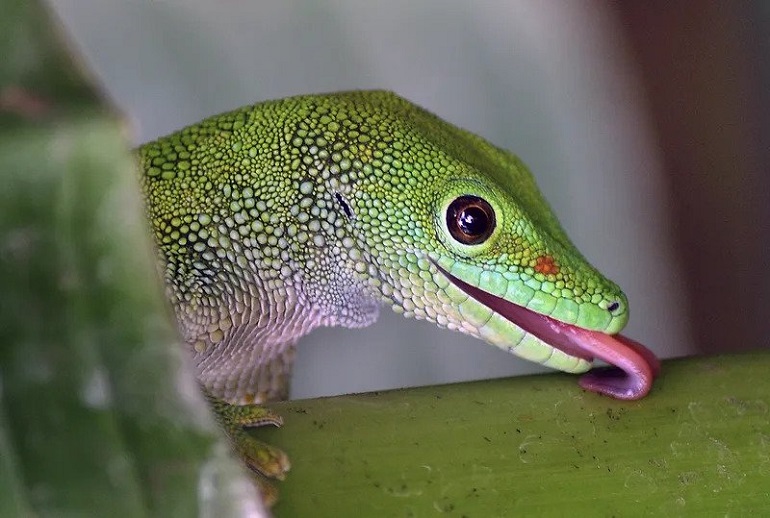
Most Geckos of the kingdom Animalia are primarily carnivores and belong to the lizard family Gekkonidae of the infra-order Gekkota. In fact, geckos are any of more than 1,000 species of lizards making up six families of the suborder Gekkota.
Most are small, ranging from 1.6cm to 60 cm (0.6″ to 23.6″). Some lizards use vocalization, which sets them apart. They chirp or click to communicate. Some make a boisterous mating call or alarming hissing noises. Geckos are the largest lizard group, with 1500 species in the order Squamata.
Leopard Geckos
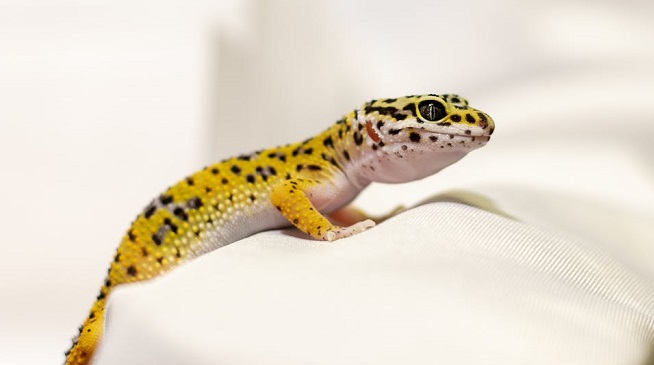
Leopard Geckos are the first captive-bred domestic lizard. They’re native to rocky desert habitats in Afghanistan, India, Iran, and Pakistan. Their spotted skins resemble a leopard pattern. A Leopard Gecko makes a regular appearance in pet stores.
African-Fat Tailed Geckos
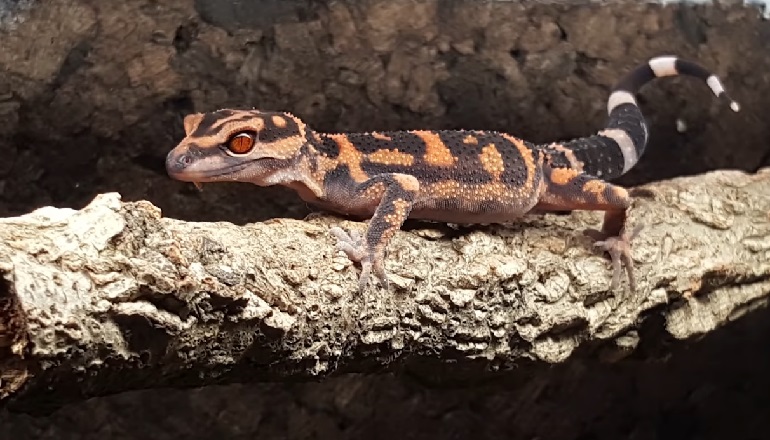
Fat-tailed Geckos have a vast terrain in West Africa, Cameroon, Senegal, and Nigeria. These versatile geckos survive dry and wet-dry Savannah habitats. They prefer dark, humid hiding crevices.
What sets Fat-tailed Geckos apart aside from their broad tail, is that they’re terrestrial and have movable eyelids and vertical pupils.
Fat-tails are larger, with pale pink or off-white underside, but their scale pattern and color vary depending on location. They don’t have adhesive pads.
Crested Geckos
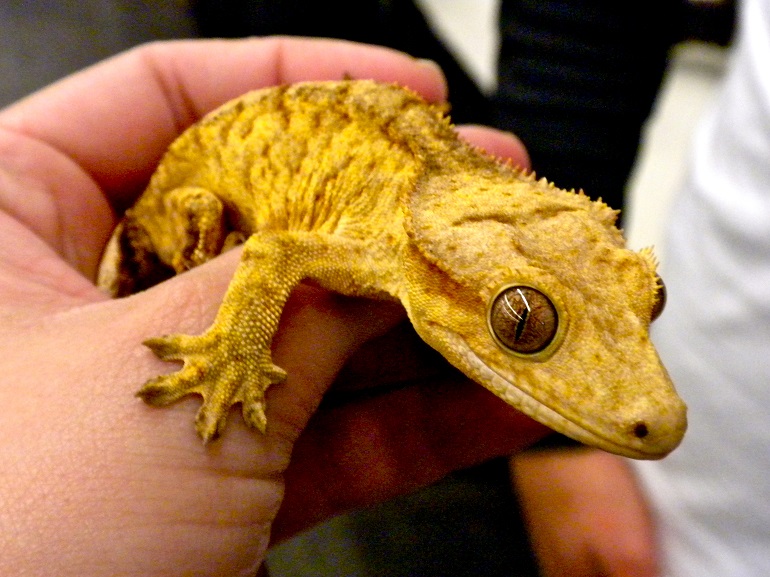
Often called the Eyelash Gecko and believed to be extinct until it resurfaced in 1994, the New Caledonian giant gecko inhabits the tip of the island (Pacific Ocean region). The Crested falls under the Convention on the International Trade in Endangered Species of Wild Flora and Fauna Protection.
Though slightly larger than other geckos, 15-25cm (6″ -10″) with a tail nearly half its body size, Cresteds have a prominent hair-like feature that resembles eyelashes. They don’t have eyelids, and a transparent scale moisturizes the eye.
If a Crested Gecko drops its tail, it will not regrow. Their toes are covered in hair and have claws to help them cling when their toes can’t.
Common House Geckos
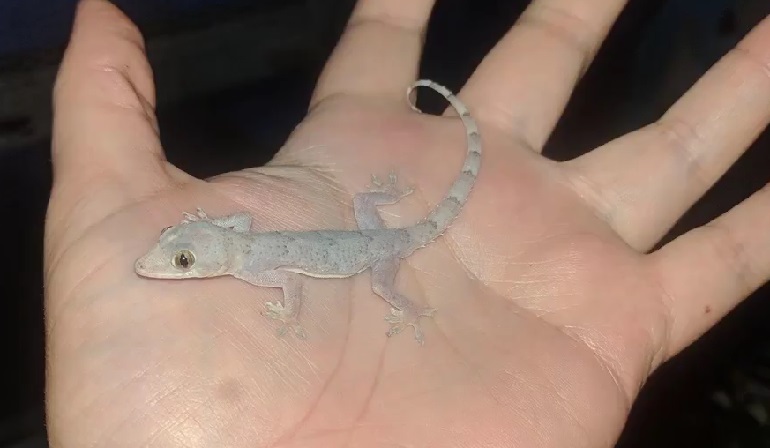
Common house geckos have many names: wall gecko, house lizard, tayoto, chipkali, moon lizard, Asian house gecko, and Pacific house gecko. They’re nocturnal and feast on insects at night. They gravitate toward light fixtures and make chirping-clicking noises. They’re medium size (7.5-15 cm /3″ -6″) with an average lifespan of 7 years.
Common house geckos are non-venomous but can bite. Like many species, they’re tropical lizards that prefer warm, humid terrain like deteriorating wood rich with insect life and urban locations. They resemble the Dubious Dtella, a native lizard in Australia and Papua New Guinea.
Gargoyle Geckos
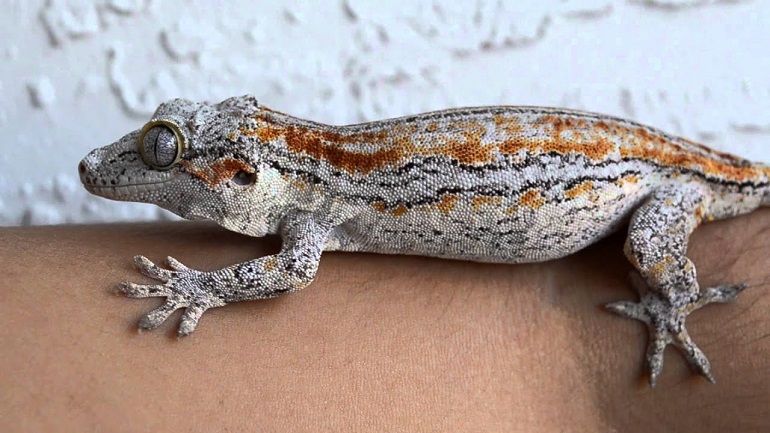
Knob-headed giant geckos or New Caledonia bumpy geckos live on the southern tip of New Caledonia. Due to massive deforestation, this small species is threatened by habit loss. The Gargoyle Gecko is the smallest of its genus (6) and is on the list for CITES to receive the protected status and restrictions on export.
This fascinating reptile gets its moniker from the cranial lesions that look like horns or external ears. Its prehensile tail regenerates and has a small toe pad that allows it to grip vines and twigs.
It is an arboreal species and lives in a scrub forest. It can’t climb smooth surfaces or vertical glass. Some are only one inch in length but reach 18-23cm (7″ -9″).
Tokay Geckos
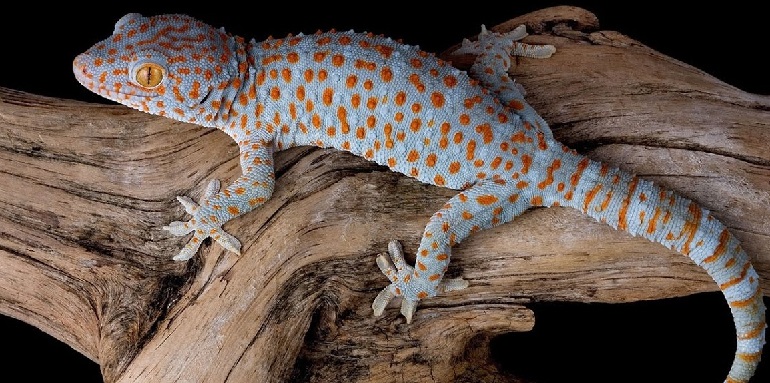
Tokay-tokay is the unique sound of Tokay Gecko males. This species is unique to Asia and a few Pacific Islands. Its extensive territory includes India, Bhutan, Nepal, Bangladesh, Thailand, Philippines, Malaysia, Indonesia, and Southeast Asia.
It’s a rainforest dweller and thrives on cliffs and trees. But, it adapts to human invasion and roams on ceilings and walls to hunt for insects.
Although not native to the USA, it’s found in Florida, Hawaii, Martinique, and the islands of Belize. It is a nocturnal animal that grows 25-30 cm (10″ -12″) and is as long as 40cm (16″), and is one of the largest species (3rd).
It has soft bluish-gray skin with unique red and orange spots. It can camouflage well and has foot pads that make it a proficient climber.
Giant Day Geckos
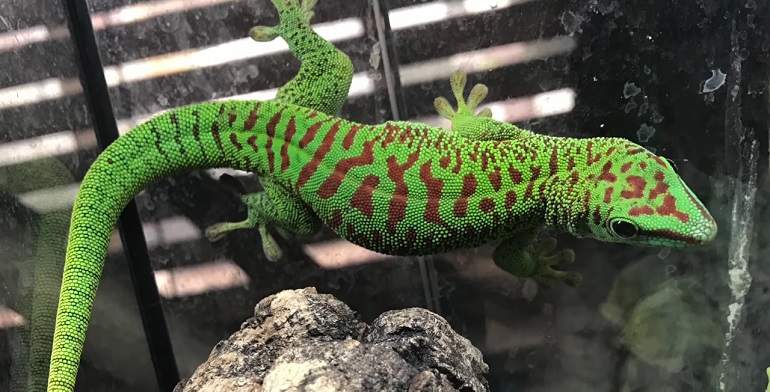
Diurnal arboreal day geckos belong to the Phelsuma group of 70 species and subspecies. True to its name, the Madagascar giant is native to tropical and subtropical forest regions in the north of Madagascar. It’s part of the thriving breeding exotic pet trade.
Large and bright green (or blueish green on occasion), this lizard with a red stripe across the nostril to the eye measures 23-28cm (9″ -11″).
Not all Giant Day Gekko geckos have the distinguishing red mark; others have tiny blue freckles. Adults might develop large calcium storage sacs on their necks. When this lizard expresses stress, it darkens in color.
Common Traits
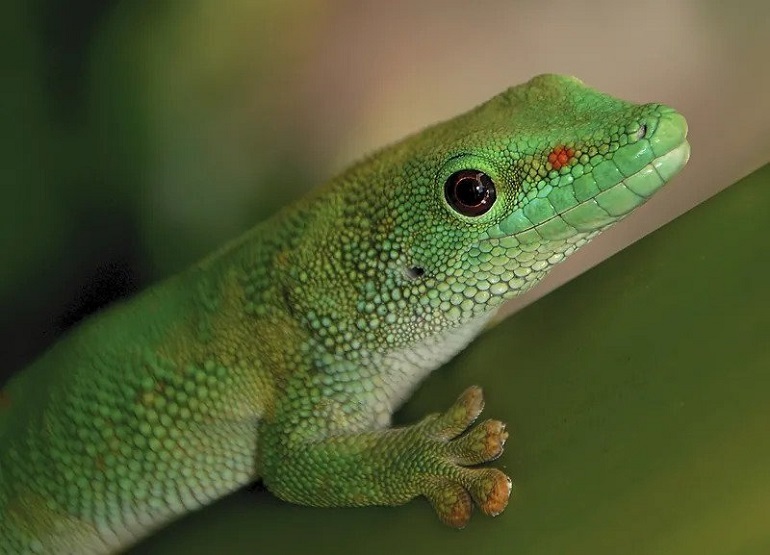
Gecko from the suborder of Gekkota is a lizard species within six families of the Gekkota suborder (sounds like a Mafia family). Most geckos are nocturnal and small. They have short bodies and large heads. Their limbs are developed for climbing, and they have setae pads.
Geckos are very adaptable and live in urban areas, deserts, and jungles and feed on insects and sometimes flower nectar. Like other reptiles, they’re ectothermic and can’t produce much metabolic heat. Their body temperature is relevant to their environment.
Shedding or Molting
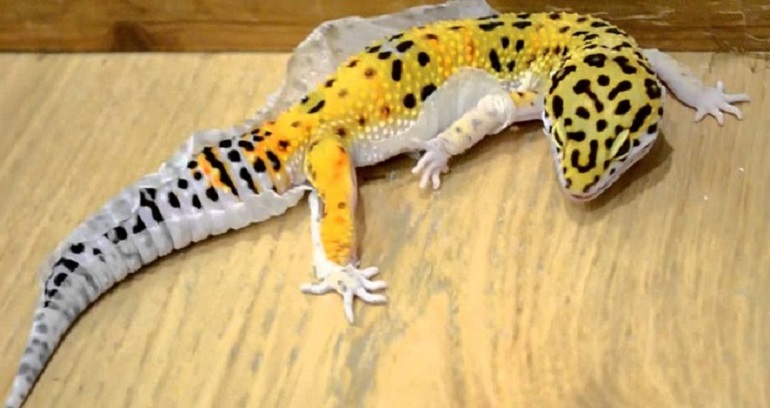
Like other reptiles and lizards, geckos shed at intervals. However, each species develops its own rhythm and method.
Leopard geckos, for example, shed every two to four weeks in humid conditions. A gecko helps the shedding process by eating and detaching loose skin. Young geckos shed once a week until they reach maturity.
Ability to Adhere
Geckos are an evolutionary masterpiece. The ability to adhere to most surfaces exists in about 60% of geckos and appears and disappears in the geckos’ evolutionary trajectory. Adhesive toepads became non-existent in at least nine lineages and evolved independently in about eleven groups.
This ability to adhere to flat surfaces stumped biologists and scientists who mistakenly believed that some chemical force (Van der Waals’ forces) was at work. However, since 2014 further evaluation suggests that this unique mechanism works with electrostatic interaction.
These adhesive footpads, called setae, are self-cleaning. Some poly materials with low surface energy make it difficult for gecko feet to adhere to. Setae work best in higher humidity, yet don’t work in water.
Further study into surface energy and molecular water layers is ongoing. Another exciting feature is the geckos’ digital hyperextension.
In essence, when a gecko moves its adhesive setae, it’s similar to removing the adhesive tape and reapplying it with the same adhesion.
Gecko Lifespan
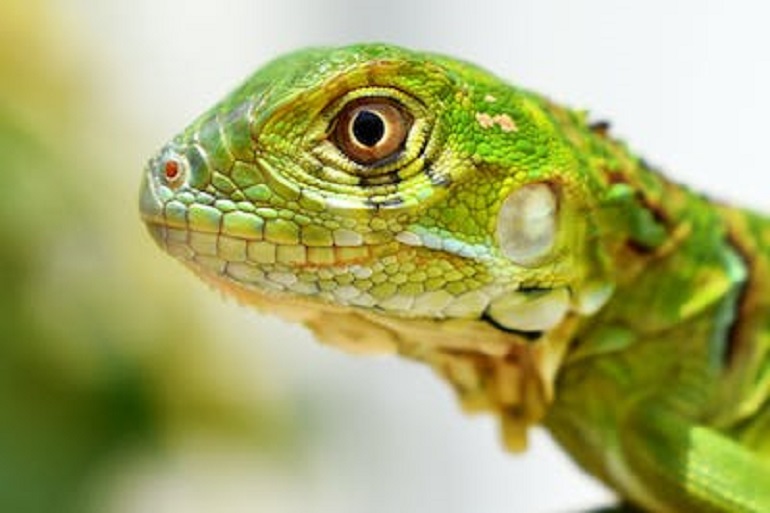
Geckos, like most animals, live in constant threat from human invasion into their fragile ecosystem. Yet geckos have learned to adapt and live among us. This explains why the oldest fossil found is 100 million years old.
Geckos, as pets, live an average of 10-20 years, but some have lived well past this range. Other factors are gender and whether it lives in the wild or captivity.
Since geckos are relatively new to the pet trade industry, there’s much to discover about their lifespan. It’s difficult to predict how long geckos survive in the wild, but estimates suggest, on average, seven years.
Chart courtesy Reptile Hero
The Ideal Gecko Habitat
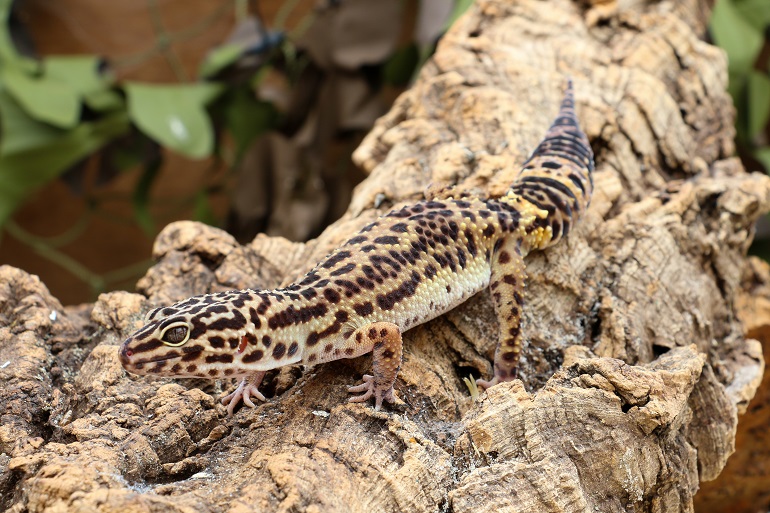
The ideal gecko habitat is in the wild. However, since keeping geckos as pets have become a widespread trade, a gecko needs a few necessities. Since geckos have a long lifespan, it takes a commitment. Experts suggest a 76-liter or 20-gallon glass tank. There are many benefits to choosing the glass.
For starters, glass allows gecko owners to watch their gecko in action, which in most cases is at night. Glass is easy to clean and decorate. Glass tanks are functional and provide a location to attach and monitor the thermometer. The optimum temperature for geckos is essential.
Tank Size
Creating the ideal environment for your gecko is paramount to its health and survival. Some people have great success keeping their gecko pets in these tank-size habitats.
- 38-liter or 10-gallon tanks
- 57-liter or 15-gallon tanks
- 76-liter or 20-gallon tanks
The tank shape also impacts the type of gecko you bring home. Leopard geckos like long and shallow tanks. Leos like ground space, while chameleons or tree-dwelling geckos like taller, more narrow tank shapes.
Material is another consideration for gecko owners. If the gecko has adhesive pads, remember that some poly plastics don’t create enough surface energy for the setae to adhere to. Glass is the best solution. Glass is also durable, easy to clean, and disinfect. It offers owners a 360-degree view.
Plastic (PVS or ABS) tanks are a durable option. They’re break-resistant, lightweight, and can retrofit wiring. The downside is that plastic terrariums are opaque on most sides and are prone to scratching.
Wood is okay, and DIYers can build inexpensive enclosures with a glass front or mesh wire. Creative individuals can turn wooden terrariums into multi-purpose bookshelving. The negatives for wood are that it absorbs water. Water can leak and create mold, and wood is notoriously difficult to disinfect.
Substrate
A substrate is vital to a pet gecko’s well-being. The flooring is the surface material on which a gecko spends much of its time. This is especially true for ground-dwelling geckos like Leos. Since they hunt, eat, and lay eggs on it, it’s vital to get it right.
The majority mistakenly believe that tossing a bit of sand and a few rocks on the bottom of the tank is sufficient. The type of flooring should match the type of gecko. Leos don’t come from sandy regions. A gecko can easily ingest the wrong substrate material like walnut, gravel, or calcium sand.
For example, a suitable substrate for Leopard Geckos is slate, excavator clay, river rocks, and pebbles. But not sand, bark, or forest substrates. The ideal substrate mimics the type of geckos’ natural environment.
Furniture
Geckos don’t need miniature sofas and mini-fridges; they need habitat accessories like branches, rocks, and natural habitat materials to allow the animal to hide and feel safe. Also, since they don’t have a metabolic body heating and cooling system, the furniture you provide needs to allow it to warm or cool its body.
Gecko’s Skin and Teeth
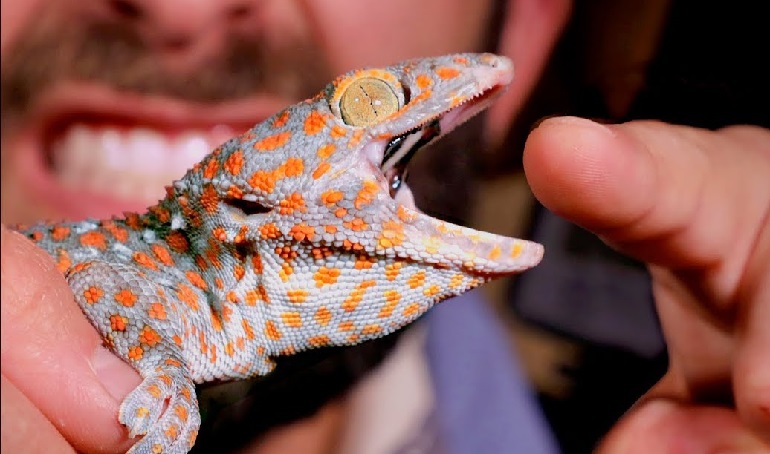
One of the most surprising things about most geckos is the soft texture of their skin. Humans have this misconception that it would feel dry, scaly, and kind of gross.
Gecko skin is closer to a hair-like texture under close surveillance than scales. These minuscule hairs have an anti-bacterial property. Further, the mossy, Leaf-tailed Gecko has camouflage systems that allow its skin to resemble tree bark, including lichen and moss. This gecko also has skin flaps that make its outline invisible.
Some Gekko gecko bite when threatened. They have about 100 teeth that naturally replace every 3 to 4 months, making them polyphyodont (a word no dentist wants to hear). Each full-grown tooth has a replacement in development. Most reptiles like crocodiles or toothed fish are polyphyodonts, and their babies hatch with teeth.
Anyone who has ever traveled to Mexico or Central America has watched native geckos feast on insects on the ceiling. Most geckos are insectivores, but some enjoy feeding on flower nectar and fruit. Pet geckos can eat fruit pure with supplements for their diet.
Those interested in keeping a pet gecko know that African fat-tailed, house, and Leopard geckos are insect eaters. Crested and Day geckos are frugivorous, meaning fruit eaters.
Types of insects they eat are:
- Crickets
- Mealworms
- Superworms
- Waxworms
- Flies
It’s vital to alternate the insects on the menu to provide your gecko with all the essential nutrients for its diet. It’s easy enough to raise these insects at home or buy them at the local pet store.
Heating and Humidity
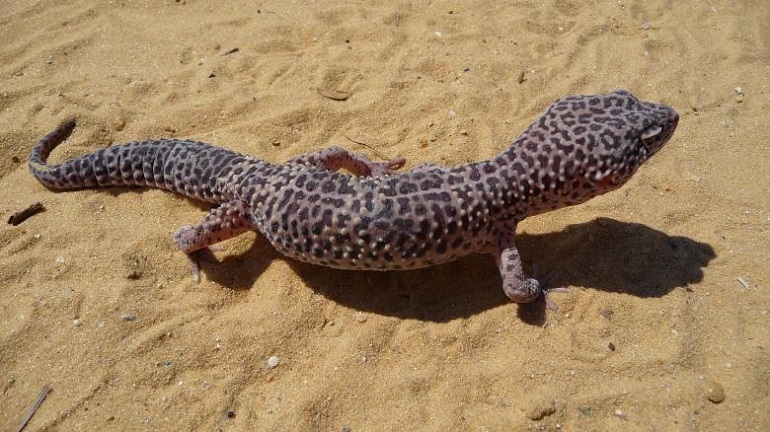
Geckos will only survive for a short time in dark, cold basements. Their ectothermic bodies rely on their environment for heat. Therefore, keeping a consistent temperature in the tank is crucial. However, geckos need a warm and cool spot in the terrarium to regulate their temperature.
Create an ambiance that provides a basking area between 24 to 29°C ( 75 to 85°F) during the day or even higher to 32°C (90°F) for that tropical vibe. Reduce the temperature during the night but keep it above 21°C (70 +°F).
Using terrarium lights, ceramic heaters, or a heating pad works well. Specific black and red reptile lights are a good source of non-intrusive light and heat. However, pair them with a heating pad. Heat rocks or direct heating will harm a gecko’s fragile skin.
Handling Your Gecko
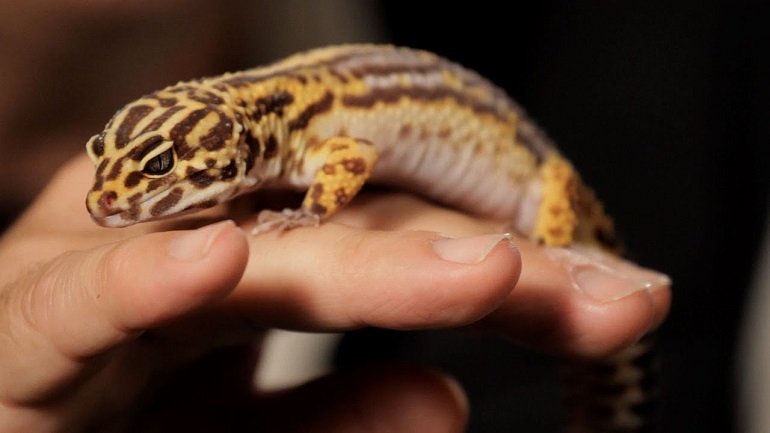
The temptation to handle a new gecko is exciting, but remember that this reptile just endured a stressful exchange with a human. Instead, introduce it to its new environment and watch it through the glass. That way, it can get familiar with your presence. Also, ensure you monitor it for food intake.
After the initial waiting period, put your hand inside the tank for a few minutes allowing your scent and movements to become familiar. Don’t use any hand lotion or strong perfumes, or medical ointments. Repeat nightly for another two weeks.
Begin handling the gecko for a 5-minute session. Hold it inside the tank, so it doesn’t accidentally slip from your hands. Support its entire body with the palm of your hand. Don’t grab the tail, as it might come off.
Taxonomy and Classification
There are seven families with about 125 genres of geckos in the infra-order Gekkota (including pygopods (snake-like). They are part of the Squamate reptiles.
These families are the following:
- Carphodactylidae
- Diplodactylidae
- Eublepharidae
- Gekkonidae
- Phyllodactylidae
- Pygopodidae
- Sphaerodactylidae
Dibamidae, or legless lizards (blind lizards), are no longer part of the Gekkotan class due to molecular phylogenies advances.
Evolutionary Development
Close relatives of the gecko family are species of lizards that date back to the Late Jurassic era. Some of the oldest fossils date back to 100 million years ago, and these gecko ancestors had similar gecko feet. More than 1850 different species of geckos exist worldwide.
Common Gecko Health Problems
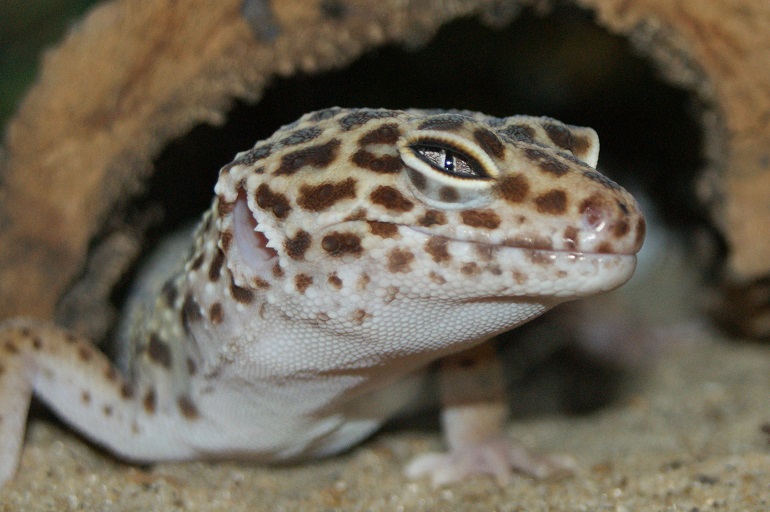
Geckos are popular pets; many health problems come from their tank environment. Changes in your gecko’s eating habits could be signs of poor health. Consult with a reptile vet.
Any captive animal depends on its owner to provide a safe environment suitable for the type of reptile. Don’t introduce foreign objects that are not conducive to their environment.
Impaction
This common health problem can be fatal for a gecko. Impaction happens when a gecko swallows an article like sand or oversized food that it can’t digest because it’s too large.
Parasites
Parasites transmit through contact with infected animals or infected food sources. Geckos will vomit, regurgitate, and suffer from weight loss, and their tail will thin out (fat storage). Loss of appetite and lethargy are two dominant symptoms. Sometimes deworming treatments help.
Respiratory Infections
Utterly avoidable if you monitor and regulate the temperatures properly for the gecko species in your care. Reptiles need heat and cooling sources. Lethargy, difficulty breathing, or breathing with their mouth open are indicators of chest problems.
Shedding
Geckos shed on a regular schedule and eat their skin–yum! If you notice skin clinging to the gecko’s toes, feet, head, or tail, ensure the terrarium has a good humidity factor or a humid hide box. If the gecko needs help shedding, moisten the area with warm water, then gently peel.
Tail Shedding
Geckos shed their tail when they feel threatened. It’s a remarkable escape mechanism. Not all gecko species regrow their tail, and it’s a fat storage tool and balancing mechanism, so it’s essential for their well-being. Provide them with the right temperature, humidity, good food, and clean water.
Metabolic Bone Disease
Although geckos are primarily nocturnal, they get their vitamin D3 from the sun. In captivity, they can get this essential vitamin from UVB lights or a dietary supplement. A low calcium diet causes a weak bone structure. Ensure your pet gets quality food dusted with calcium.
Reproduction
Unlike most species, reptiles reach sexual maturity based on size and weight rather than age (typically 18 -24 months). Many of the species lay small clutches of eggs in the breeding season. Some live young, and others reproduce asexually.
Geckos have temperature-dependent sex determination, meaning the temperature influences gender.
Many species have a distinguished mating ritual. Most are egg-laying or oviparous. Females lay one or two eggs in a clutch and reproduce once per breeding season. Other species, like the Leopard or Tokay gecko, have four to six clutches.
Cleaning the Gecko Tank
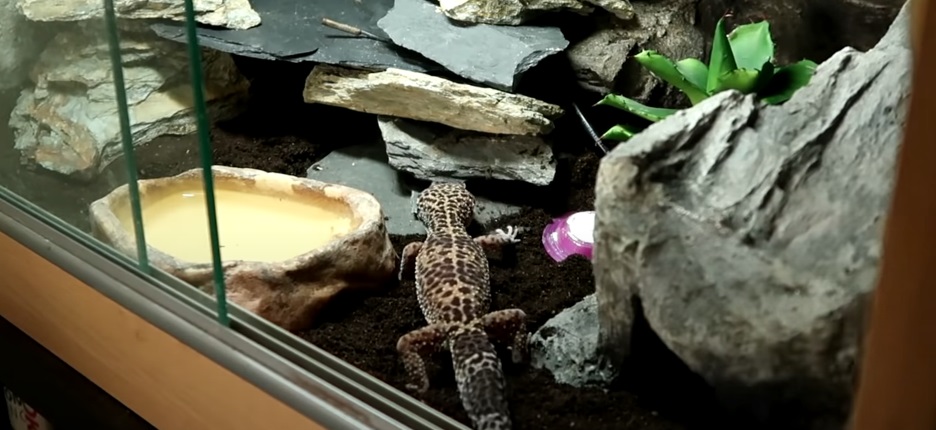
First and foremost, have a cleaning schedule and thoroughly wash and clean the cage every two months. Spot clean daily to avoid a buildup of feces and debris.
Wash the tank with hot soapy water (mild dish detergent or reptile specific) and then rinse thoroughly with clean water. Once it’s clean, follow up with disinfectant. Although some people use diluted chlorine solutions, a reptile-safe solution is better. Apply the solution and leave for 30 minutes and rinse.
Wash all the accessories and disinfect them thoroughly. Allow drying completely before returning them to the cage. Damp items can breed bacteria. Make sure your gecko is in a safe place while you’re cleaning.
Conclusion
Geckos are fascinating reptiles to watch. They allow children to learn about a unique species and also responsibility. Geckos are great for individuals who can’t have cats or dogs due to space or allergy constraints.
Gecko enthusiasts appreciate this lizard family’s attractive appearance, habits, and activities.


